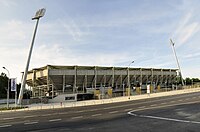|
2017 UEFA European Under-21 Championship
The 2017 UEFA European Under-21 Championship (also known as UEFA Under-21 Euro 2017) was the 21st edition of the UEFA European Under-21 Championship, a biennial international youth football championship organised by UEFA for the men's under-21 national teams of Europe. The final tournament was hosted in Poland for the first time, after their bid was selected by the UEFA Executive Committee on 26 January 2015 in Nyon, Switzerland.[1] The tournament took place from 16–30 June 2017.[2] Players born on or after 1 January 1994 were eligible for the tournament. In March 2012, UEFA announced that the competition would take place in even numbered years from 2016 onwards.[3] In September 2013, UEFA announced its intention to continue holding the final tournament in odd numbered years following a request from its member national football associations.[4] On 24 January 2014, UEFA confirmed that the final tournament would be held in 2017 and that it would be expanded from 8 teams to 12.[5] HostsThe hosts were announced at a meeting of the UEFA Executive Committee in Nyon on 26 January 2015. In late April 2014, the Polish Football Association very strongly indicated the country has high chances to host the tournament. Bidding to welcome Europe's best youth teams was one of the reasons for Poland's withdrawal from the UEFA Euro 2020 race.[6] QualificationA total of 53 UEFA nations entered the competition (Gibraltar did not enter, as per usual), and with the hosts Poland qualifying automatically, the other 52 teams competed in the qualifying competition to determine the remaining 11 spots in the final tournament.[7] The qualifying competition, which took place from March 2015 to November 2016, consisted of two rounds:[8]
Qualified teamsThe following 12 teams qualified for the final tournament.[9] Note: All appearance statistics include only U-21 era (since 1978).
Final drawThe final draw was held on 1 December 2016, 18:00 CET (UTC+1), at the ICE Congress Centre in Kraków.[10][11] The 12 teams were drawn into three groups of four teams. The teams were seeded according to their coefficient ranking following the end of the qualifying play-offs, with the hosts Poland assigned to position A1 in the draw. Each group contained either the hosts or one team from Pot 1, one team from Pot 2, and two teams from Pot 3.[12][13]
VenuesOn 7 June 2016, Polish Football Association selected six venues:[14]
Match officialsIn February 2017, UEFA selected nine referees and their teams for this tournament.
SquadsEach national team had to submit a squad of 23 players, three of whom had to be goalkeepers. If a player was injured or ill severely enough to prevent his participation in the tournament before his team's first match, he could be replaced by another player.[8] Group stageThe group winners and the best runner-up advanced to the semi-finals.
Teams were ranked according to points (3 points for a win, 1 point for a draw, 0 points for a loss), and if tied on points, the following tiebreaking criteria were applied, in the order given, to determine the rankings (Regulations Articles 18.01 and 18.02):[8]
All times are local, CEST (UTC+2).[16] Group A
Group B
Group C
Ranking of second-placed teams
Source: UEFA
Rules for classification: 1) points; 2) goal difference; 3) goals scored; 4) disciplinary points; 5) coefficient (Regulations Article 18.03).[8] The match-ups of the semi-finals depended on which runner-up qualified (Regulations Article 17.02):[8] Scenario according to the qualified team
Knockout stageIn the knockout stage, extra time and a penalty shoot-out were used to decide the winner if necessary.[8] On 2 May 2016, the UEFA Executive Committee agreed that the competition would be part of the International Football Association Board's trial to allow a fourth substitute to be made during extra time.[18] Bracket
Semi-finals
FinalGoalscorersThere were 65 goals scored in 21 matches, for an average of 3.1 goals per match.
Source: UEFA.com[20] AwardsThe following awards were given at the conclusion of the tournament:
Team of the tournamentAfter the tournament, the Under-21 Team of the Tournament was selected by the UEFA Technical Observers.[23]
Sponsorship
References
External linksWikimedia Commons has media related to UEFA European U-21 Championship 2017.
|
||||||||||||||||||||||||||||||||||||||||||||||||||||||||||||||||||||||||||||||||||||||||||||||||||||||||||||||||||||||||||||||||||||||||||||||||||||||||||||||||||||||||||||||||||||||||||||||||||||||||||||||||||||||||||||||||||||||||||||||||||||||||||||||||||||||||||||||||||||||||||||||||||||||||||||||||||||||||||||||||||||||||||||||||||||||||||||||||||||||||||||||||||||||||||||||||||||||||||||||||||||||||||||||||||||||||||||||||||||||||||||||||||||||||||||||||||||||||||||||||||||||||||||||||||||||||||||||||||||||||||||||||||||||||||||||||||||||||||||||||||||||||||||






